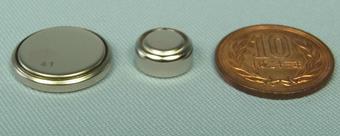Accidental swallowing of the button battery is extremely dangerous.
There are numerous accidents involving button batteries, particularly in infants and toddlers. Some of them are extremely dangerous, even if they are directly linked to the danger of life. However, the Consumer Affairs Agency has reported that infant and child guardians are not fully aware of the danger.
It is important to be aware of the danger of accidental swallowing of button batteries in order to prevent accidental swallowing of button batteries and to take appropriate measures in the event of an accident, so we will explain it by extracting from the publications of the National Lifestyle Center.
(from National Lifestyle Center media)
1. Button Battery Hazard
Button batteries are batteries whose diameters are larger than the thickness. Depending on the shape of the batteries, there are coin-shaped and button-shaped batteries. Many coin types are thinner than button types, and have diameters as large as about 2cm, making them very similar to coins. In addition, lithium batteries, often used in coin-type batteries, have discharging voltages as high as 3V compared to button-type 1. 5V batteries, which maintain a constant voltage until the battery is used up.
Shape of Button Battery (Example)

2. Chemical burns due to alkali formation
When a button battery is swallowed, current flows from the battery that contacts the digestive tract, and electrolysis creates an alkaline liquid on the outside of the battery (the negative electrode side). This alkaline liquid dissolves protein and can cause damage to the walls of the digestive tract in a short time. In a test in which a button battery was placed on poultry, we confirmed that the battery was damaged enough to form a battery-shaped indentation in 20 minutes.
Because of this strong alkali, if the batteries are not removed quickly, there is a risk of collapse or perforation in the digestive tract. In particular, coin-cell lithium batteries have a higher discharge voltage, are wider and flat, and tend to stagnate in the esophagus and other places, increasing the risk of accidental swallowing.
In the case of the button type smaller than the coin type, the battery inserted into the nose of an infant produces alkali as it was when swallowed, causing serious tissue damage. In the stomach, corrosion of the metal film of the battery occurs in the stomach fluid. Alkaline manganese batteries, which use alkaline liquids for the contents of batteries (electrolyte), also pose the risk of alkaline liquids flowing out and damaging the walls of the digestive tract.
3. Advice from expert
If a child swallows a button battery or puts it in a nose hole, it is important to go to medical facilities as soon as possible. In the worst case, you should call an ambulance immediately, as there is a risk of death. If you can check the type and condition of the battery, inform your physician.
In addition, even if you are not sure whether you have swallowed it, you can check the presence or absence of button batteries and the area where batteries are stagnant by taking an X-ray. Be sure to consult with a qualified person if there is a possibility of swallowing. (Dr. Tatsuhiro Yamanaka of Midorien Children's Clinic)